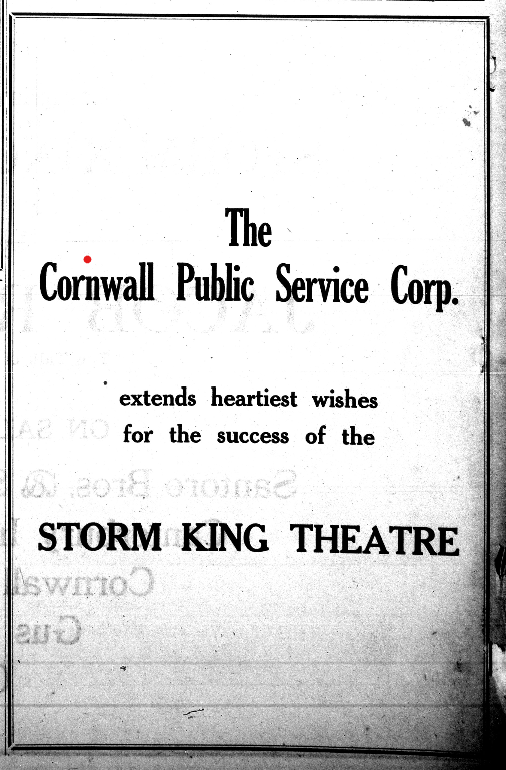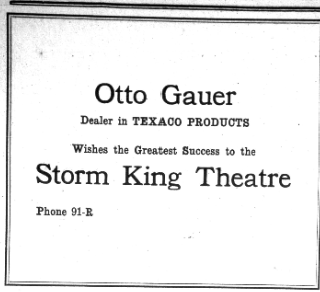Storm King Theatre Opens on July 3rd
Published in The Cornwall Local – June 27, 1935
By D. Deane
DESCRIPTION OF STRUCTURE
The auditorium of the Storm King Theatre represents the very latest in design and arrangement for comfort, convenience and provides the last word in visibility and acoustical perfection.
The seats are divided into two classes, the orchestra and the loge. The first advantage of the loge, which are slightly higher in price, is that they have plush padded backs, while the backs of orchestra seats are covered with leather. Also, there is slightly more room between the rows in the loge section than in the orchestra, thus giving more leg stretching possibilities.
The proletariat, nevertheless, may take orchestra seats without any feeling of inferiority since there are just as many springs under the leather cushions of the orchestra seats as under those of the loge seats, and the orchestra section (myopics please note) is nearer the screen than are the loges.
Great care has been taken that the acoustics shall be perfect. The rear wall of the auditorium is porous so that the sound may not rebound to create an echo. Since it has been found that sound is caught by a balcony making blind spots in the audience, the Storm King Theatre has seats on only one level!
Patrons are assured of comfort, both physical and mental. There need be no worry over the fire hazard, for the only wood in the building is a little on the stage, and the arms of the seats. The floors are a composition except in the auditorium which has a concrete floor. There are two aisles leading to the stage and one crosswise aisle between the loge section and the orchestra. On each side is a ramp which leads directly outside the building. The third ramp, close to the stage provides a speedy exit from there if necessary. There are the usual fire extinguishers also.
Those susceptible to colds will be interested in the very efficient ventilating and air-conditioning system installed in the basement by Shaker, Travis and Quinn. Cool air is continually blown out over the eight flat plate glass lighting fixtures in the ceiling of the auditorium, while the warm used-up air is sucked down by instruments under the seats. These are set in pairs, two pairs per row of seats. They are attached quite inconspicuously to the legs of the seats, and they occur at intervals all down the center section of the auditorium.
Besides this complicated arrangement, there are ordinary ventilators in the back of the theatre, in the lobby, in the lounge and dressing rooms upstairs and in the projection room.
The eight air distributors in the ceiling are also lights. They will shed a soft frosted glass light over the assembled company, and fade out slowly as the curtains part. There are eight additional side lights, four to each side, set in narrow arched niches of a soft blue color. This is the dominant shade of the auditorium. The aisles are carpeted in this shade, and the plush backs of the loge seats, the leather of the orchestra, echo and establish the restful blue tone.
The carpets are the product of the Firth Carpet Company. They have a conventional overlapping shield pattern and are pleasing to the eye as well as most satisfying to walk on.
The upper part of the walls and the ceiling are a light cream, but the lower part, to a height of about six or seven feet, add variety to the color scheme by their plaidlike square pattern of brownish yellow. The two parts of the wall are divided by a band of dull silver. Another bit of variety is the gay-colored conventional border which runs around the ceiling matching the border in the lounge.
The lower walls have a Mexican Indian look, and the colors are blue, yellow, and green to match the footlights. The great outer curtain of the screen is of the rich deep blue of the ceiling, relieved by three stripes near the bottom. Behind this outer curtain, however, and covering the screen, is another curtain, all of dark amber, with three blue stripes.
The whole great wall has an air of luxury and quiet good taste, largely due to the subdued, pleasant color scheme and the sweeping majestic curtains.
Upstairs in the lounge, the tone is entirely different, though in just as good taste as the auditorium. Here the atmosphere is built on cheerfulness. The floor is green in both the lounge and lobby of the same plaid pattern as the auditorium. The lower walls of the lounge and the lobby are all bluish green—the turquoise shade so popular in ladies’ dresses recently.
Walls and ceiling are light cream, unadorned except by white sidelights in the lounge, bordered to match the auditorium in the lobby.
The furnishings in the lounge are all very modernistic. The divans are upholstered wholly in clear canary yellow; the chairs have seats of the same shade but their backs are white. All are of clean washable leather. Black and white lamps illumine the lounge. Parchment shades are decorated with a very metropolitan looking silhouette design of skyscrapers.
To sum up, the inside of the theatre is as lovely as the outside promises. As it stands, the Storm King Theatre is a great improvement to the village. The black tiled border, the concrete walls and the black and white, silver-trimmed marquee are attractive and appropriate.
The New Theatre
EDITORIAL
Welcome and all best wishes to the Storm King Theatre. Cornwall has long needed a theatre of its own, and the Storm King seems, to praise it highly, quite worthy of our village.
The cinema is a great educational force. Whether it is a great director of public opinion, or whether it is public opinion which moulds the cinema, is a controversial question.
To us, the critics, is the task of spurring the cinema on to higher achievements. On our side too, there is need for sincerity, thoughtfulness, and courtesy. But the critic whose opinion has the most weight is the man who shows his approval by his patronage.
The new Storm King Theatre, we hope, will pick and choose its presentations to conform to a high standard indeed. For the general and individual welfare, we hope that the patrons will support that standard at its highest, and correct if need be. Legion Fund To Benefit From Opening Show
This issue of the Cornwall Local is primarily to announce the opening of the Storm King Theatre. The advertising in this issue was solicited by the members of Cornwall Post, American Legion, and the proceeds will be used by them in their welfare work.
They also will handle the sale of tickets for the opening night performance, the proceeds to be used for the same purpose.
The tickets are fifty cents each and are on sale at Robert Smith's in Firthcliffe, Al Gustafson's on Hudson Street, the Storm King Restaurant on Hudson Street, and at Edwin Mersebes on Main Street in Canterbury.
As we go to press, no announcement has been made as to what will be the opening feature, but it is expected that the opening performance will be of especial brilliance.
Due to the fact that considerable advertising for this issue has been received since the printing of the issue was begun, it has been necessary to omit many personals and other items, which will be published in the next issue.
June 28th article from The Newburgh News:
Cornwall’s New Show Place Scheduled to Open July 3
American Legion Will Sponsor Opening of Fine Structure Located on Site of Old Matthiessen Hall in Lower Village
Cornwall-on-Hudson — The Storm King, one of the finest small motion picture theatres in New York State, will be opened on Wednesday, July 3. The first showing will be sponsored by Cornwall Post American Legion.
The village’s first and only theatre, it seats 600.
The building, which occupies a corner at Idlewild and River Avenues, is of colored stucco construction, 65 feet on River Avenue. Of modernistic design, two-thirds of the structure is one story high along Idlewild Avenue, while the portion of the building fronting River Avenue, containing a lounge, rest rooms, projection room, and offices over the lobby, is two stories high. It is thoroughly fireproof.
Three Store Rooms
Three large store rooms are located in the building on Idlewild Avenue. One of them is occupied by McKinney and Son, paint dealers. The Kreisel Furniture Co. of Newburgh occupies another for the display of General Electric refrigerators, and the third, the largest store, is unoccupied.
Duro aluminum is used exclusively in doors and window casings.
Interior walls and ceilings are of stucco and zenithern, with acoustical tile in the auditorium to improve sound. Blue is carried out in the auditorium. The stage has two curtains in front of the screen, a fine gold one directly in front of the screen, and the outside curtain of heavy blue plush.
Finest Lighting, Ventilation
The latest lighting effects and fixtures are employed throughout, and the ventilating and air conditioning system is of the identical type used in Radio City Theatre, New York, according to Manager Edward Kenney.
Each seat in the auditorium is focused to the screen, so each patron may clearly see the show without moving the body. The finest type projectors will be used. The building is thoroughly fireproof.
Ed. Kenney & Associates Owners
A corporation known as Edward Kenney and Associates own and will operate the new theatre, which was made possible last September when taxpayers, meeting in the Village Offices, unanimously approved a proposition of C. H. Matthiessen that the village transfer to him Matthiessen Hall for the cost of razing it, so the site could be used for erection of a theatre.
Mr. Matthiessen’s proposal also made provision for a new public library to replace quarters in Matthiessen Hall used as a library for many years. Matthiessen Hall had previously been given to the village by Mr. Matthiessen’s father, the late E. H. Matthiessen.
2 Fine New Buildings
According to the provisions of Mr. Matthiessen’s proposal, a fine new library building has been erected and is in use in Idlewild Avenue, corner of Prospect Street, a short distance from the new theatre. The two new buildings mark a distinct forward step for the village. Erard H. Matthiessen, architect, son of C. H. Matthiessen, designed both buildings.

















